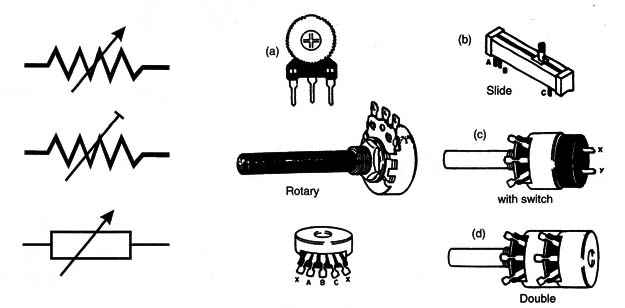As the name indicates, a variable resistor is a device presenting a resistance that can be changed. Variable resistors are found in different sizes and aspects.
There are two types. One aIIows the resistance value to be changed easily and often, Iike the vqume or tone adjustment of an audio amplifier. The other is the semifixed resistor that ordinarily doesn't change the resistance value. It is used to adjust the operational condition of the electronic circuit
Basically, variable resistors are formed by a resistive material (metal or carbon) with a cursor sliding onto it. When the resistance between the cursor and any corner of the resistive material changes normally, between O and a determined value of resistance, it is caIIed nominal resistance.
So in a 1000 Ω variable resistor, the resistance between the cursor and any of the corners can assume values between 0 and 1000 Ω.
Symbols and Types
Figure 1 shows the symbols and types of the two basic types of variable resistors.

In (a), a trimmer potentiometer or adjustable potentiometer is shown. This small variable resistor is used to adjust the operational condition of a circuit one time. They are found inside the equipment.
Size and form of mounting can change according to the application.
In (b) are potentiometers (slide and rotary) that are used to control many functions of equipment. The slide potentiometers are common in audio equipment and the rotary types are found in TV, radio, dímmers, etc.
Many potentiometers are double (d) as those used to control the volume in both channels of a stereo amplifier. Others (c) can include switches to turn on and off an appliance.
Specifications
A. Value or nominal resistance
The most important specification in a variable resistor (potentiometer or trimmer potentiometer) is the nominal resistance. This resistance is indicated in Ω (Q) and represents the maximum value of resistance assumed by the component. For example, a trimmer potentiometer preset with 10,000 Ω or 10 k ohm can be adjusted to any resistance between O and 10,000 Ω.
B. Variation of resistance
ln some applications the way the resistance changes when the potentiometer is adjusted is important. There are basically two types of variation of resistance curves: Iinear and Iogarithmic.
Where they are found
The reader can find trimmer potentiometers and potentiometers in many types of electronic equipment. In every application where a function of a circuit must be adjusted or controlled by changing current in a circuit, a variable resistor can be used.
An example of a common use is in a dimmer where the amount of current in a circuit determining the brightness of a lamp is controlled by a potentiometer. Timers also use a potentiometer to adjust the time.
Testing and replacing
Trimmer potentiometers and potentiometers can burn or present many functional problems. One of the problems is the cursor contact can fail. Another common problem is caused by noise generated when the cursor slides on the resistive element. This occurs mainly in audio equipment.
This problem is the cause of the scratching noise produced when the volume control of a radio or amplifier is adjusted.
A basic test can be done with a multimeter to measure the resistance of the resistive element (between the extreme terminals in potentiometers).
Another test is done by sliding the cursor and Iistening to hear if noise is produced (if a multimeter doesn't indicate abrupt jumps in the resistance change).



